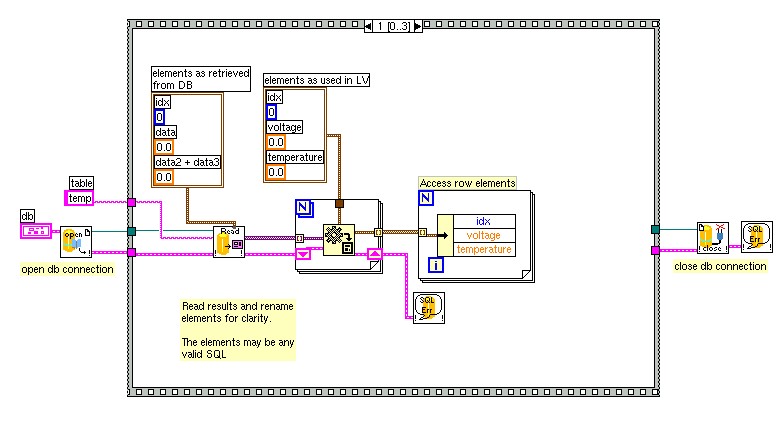sql_LV Documentation
The sql_LV library has 3 main functions;
- Gives the LabView user the ability to INSERT data into his DB
- Retrieve or SELECT data from his DB
- Process or apply arbitrary SQL to his DB
Of course, the library includes ancillary functions for opening and closing DB sockets and for error processing.
All of the following instructions for using sql_LV are based on test.vi.
Insert Data
The data cluster can be built up with constant/bundle-by-name, where
the element names match the DB column names and the element types match
the DB column types. Date/times and datetimes are handled as LV
Str types.

SELECT Data
The user needs to define a cluster constant with element
names that correspond to the retrieved field and must chose the correct
type. Once the data has been retrieved, the user must convert the
output Variant type to cluster data using the LabView function for
that. If only one row of data is selected, the output array will
be 1 element and may be indexed before, or after, type conversion.
Of course, field names may be changed for readability if desired
as in the example.

JOIN Tables
Technical data, the likes of which LabView is most used with, is often
stored as a header record with swept data results stored to another
table. Of course, SQL JOINs are exactly the method used to
retrieve such data and sql_select.vi doesn't distinguish between tables
or joined tables. An example JOIN and element renaming are shown
here.

Generic SQL
Generic SQL commands may be processed with sql_cmd.vi. The intent
is to use this VI to create tables and procedures, specifically for
your flavor of SQL.
Generic SQL commands with output may be processed with
sql_cmd_resp.vi. This works well when calling procedures or
special RDBMS functions. Also, when the user calls aggregate
functions (such as "average()" or "sum()") on large tables with
indexing, huge efficiencies can be obtained by using sql_cmd_resp.vi
and using the DB server to process the query instead of bringing all
the data into LabView (through a networking layer) and processing.




